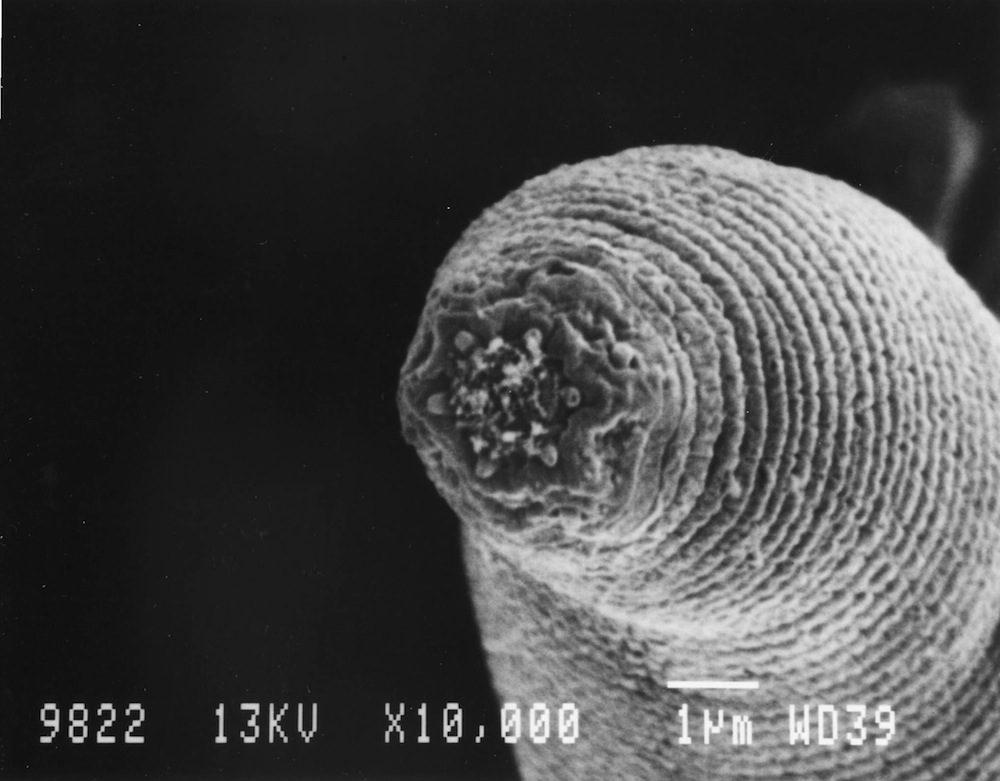Discovery of Deepest Worms Holds Promise for Mars Life

How low can worms go? According to a new study, at least 0.8 miles (1.3 kilometers) below the Earth's surface.
That's the depth at which scientists discovered a new species of worm, dubbed Halicephalobus mephisto in honor of Faust's demon Mephistopheles. The worm, reported this week in the journal Nature, is the deepest living multicellular organism ever found and opens up the possibility that multicellular life could lurk below the surface of a planet such as Mars.
"We tried to get the title of the paper to be 'Worms from Hell,'" said study author Tullis Onstott of Princeton University. "But Nature didn't go for that."
The Moby Dick worm
Onstott and his colleagues have been searching for subsurface life for 15 years, focusing on the ultra-deep mines of South Africa, which penetrate more than 1.8 miles (3 km) into the Earth. They and other teams of scientists have found that life has very deep roots, with single-celled organisms found miles underground. Some of these organisms are quite extreme: One 2008 study found life thriving a mile under the seafloor, surviving in temperatures between 140 and 212 degrees Fahrenheit (60 and 110 degrees Celsius). [Read Extremophiles: World's Weirdest Life]
But finding the multicellular, 0.02-inch-long (0.5 millimeters) H. mephisto is a different story. The worm, or nematode, lives in fluid-filled rock fractures, where it grazes on bacteria, Onstott told LiveScience.
"It's kind of like finding Moby Dick in Lake Ontario," he said. "It's so volumetrically big. It's 10 billion times the size of the bacteria upon which it feeds."
Get the Space.com Newsletter
Breaking space news, the latest updates on rocket launches, skywatching events and more!
To find the worm, Onstott and his team sampled water from mine boreholes as deep as 2.2 miles (3.6 km). They also sampled soil around the mine boreholes and filtered about 40,000 gallons of surface water to ensure that the nematodes weren't coming into the mine from above.
In the Beatrix gold mine, they found their quarry: the tiny, simple nematode, alive and capable of asexual reproduction. The researchers were able to get H. mephisto to reproduce, and the species is still "squirming around in the lab," Onstott said. [See a picture of the nematode]
The researchers found no evidence of the nematode in surface waters or soils, indicating that it is native to deep rock fractures. Chemical analysis revealed that the water in which H. mephisto lives dates back at least 2,900 years, meaning it's been down there for a while, said Rick Colwell, a microbiologist who studies subsurface organisms at Oregon State University.
"They have been quite careful in measuring the environment that these organisms come from," Colwell, who was not involved in the study, told LiveScience.
In lab experiments, the research team found that H. mephisto prefers to snack on the bacteria found in deep rock fractures, turning up its wormy nose at aboveground buffet options such as E. coli.
Worms in space?
The find could encourage researchers to expand the search for life under our own feet, said Colwell, who along with others is working on a project called the Census of Deep Life, dedicated to cataloguing what lies beneath Earth's surface.
"As we initiate this census of deep life," Colwell said, "I can see expanding it in the direction of some more complex life forms, like these nematodes."
Farther from home, the discovery of very deep multicellular worms opens up possibilities in the search for extraterrestrial life, said Michael Meyer, the lead scientist for Mars exploration at NASA, who was not involved in the study. Researchers have assumed that any subsurface life on a planet like Mars would be unicellular, Meyer told LiveScience.
"This kinds of opens it up to, well, even multicellular life could be possible," Meyer said.
This story was provided by LiveScience, a sister site to SPACE.com. You can follow LiveScience senior writer Stephanie Pappas on Twitter @sipappas. Follow LiveScience for the latest in science news and discoveries on Twitter @livescience and on Facebook.
Join our Space Forums to keep talking space on the latest missions, night sky and more! And if you have a news tip, correction or comment, let us know at: community@space.com.

Stephanie Pappas is a contributing writer for Space.com sister site Live Science, covering topics ranging from geoscience to archaeology to the human brain and behavior. She was previously a senior writer for Live Science but is now a freelancer based in Denver, Colorado, and regularly contributes to Scientific American and The Monitor, the monthly magazine of the American Psychological Association. Stephanie received a bachelor's degree in psychology from the University of South Carolina and a graduate certificate in science communication from the University of California, Santa Cruz.










